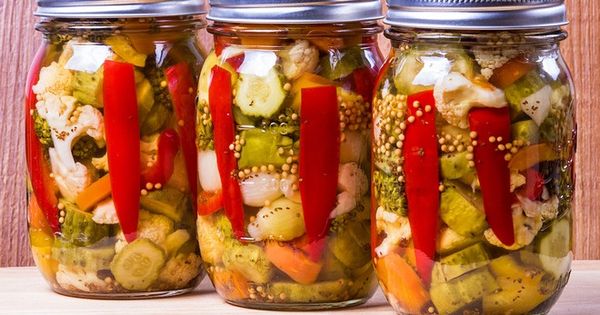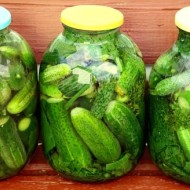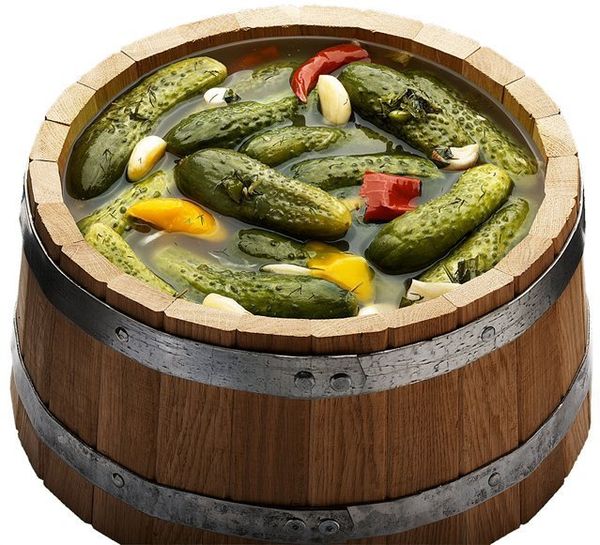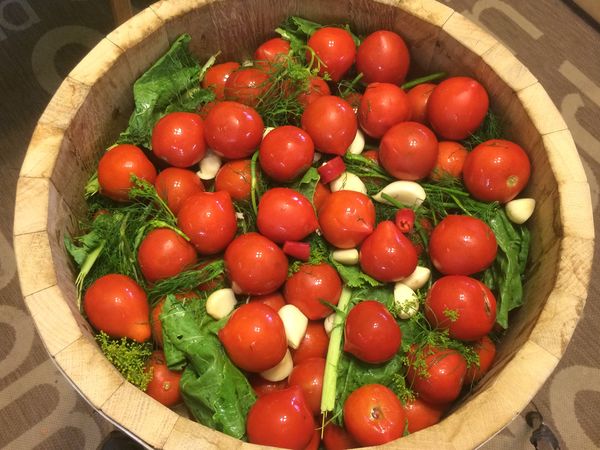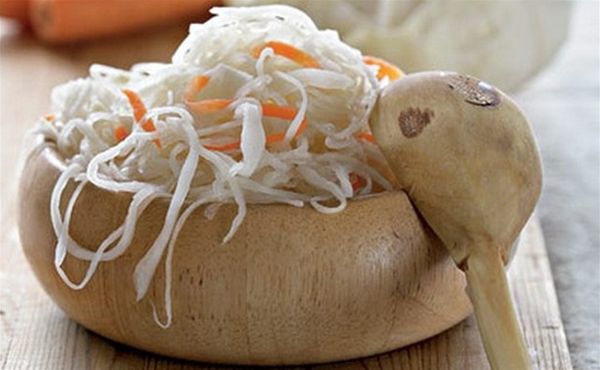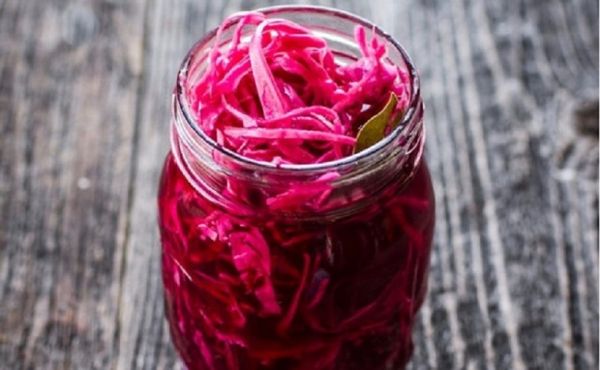The most delicious recipes for salting vegetables for the winter at home
Content
General rules
In order for the result of your efforts to please with its taste, the hostess must adhere to simple rules during the cooking process:
- Choose only ripe vegetables, without damage and foci of decay. Remember that crushed, overripe or peeled from wormholes fruits are not suitable for salting, since the imperfection of the raw materials will certainly affect the taste characteristics.
- Strictly follow the recipe - do not reduce the specified amount of ingredients, otherwise the vegetables will not be salted, but will deteriorate.
- Use the correct utensils and equipment: plastic containers, oak barrels.
The main difference between salting and no less common pickling is that salt acts as the main and only preservative. Vinegar is never used in pickle recipes.
Video "Pickling cucumbers in a barrel or tub"
From this video you will learn how to properly pickle cucumbers in a barrel for the winter.
Salt cucumbers
There are many recipes for harvesting cucumbers. They can be pickled, prepared salads and caviar from them, rolled with vinegar and spices. But the most favorite way of harvesting homemade cucumbers for our compatriots has always been and remains salting. Let's take a look at the most popular recipes.
In banks
Do not be discouraged if you do not have an oak tub on hand, like the one your grandmother used to pickle cucumbers. Believe me, cucumbers cooked according to this recipe in glass jars are in no way inferior to the famous grandmother's pickles. True, the salting process will take longer, but the result is worth the effort.
To make a three-liter jar, take the following products:
- cucumbers - how much will go into the jar;
- 1 bar of horseradish root;
- 4-5 cloves of garlic;
- 5 currant leaves;
- 2 dill umbrellas;
- 10 g mustard seeds;
- 100 g of rock salt;
- 2 bay leaves;
- 4 carnation umbrellas;
- 5 peppercorns.
Pour vegetables with clean cold water for 4-6 hours - this will make the ready-made cucumbers crispy. When the water is drained, trim off the tips of the cucumbers. We clean horseradish, cloves of garlic, prepare spices and spices. Put the cucumbers tightly in the jars, add spices and salt, fill the neck with purified water. We leave the vegetables in this form for several days - they will ferment slightly, foam will appear on the surface of the brine, and it will become slightly cloudy.
Gently pour the brine into a large saucepan and send it to the stove, let it boil for a few minutes. Fill the cucumbers with hot brine again and close with tight nylon lids. Now you can take out the cans into a cool closet and be patient for a few weeks - that is how long it takes for the cucumbers to finally "ripen".
In a barrel
Dense, crispy cucumbers, pickled in a wooden barrel according to an old recipe, are an invariable favorite of any feast, despite their seeming simplicity. For everything to work out, the preparatory work should begin in advance. The tub for the upcoming salting should be prepared several weeks in advance.It is filled with water and left for 2-3 weeks so that the tree swells and all cracks are filled.
Now we pour out the water, and thoroughly wash the keg inside with a solution of soda and rinse with clean water. Shortly before laying the vegetables, the barrel is poured over with boiling water. We select cucumbers about the same size, wash them, scald them with boiling water and immediately dip them into ice water - this way the vegetables will retain their natural color.
In a standard barrel, designed for 45-50 kg of cucumbers, 2 kg of dill umbrellas, leaves and horseradish root - about 200 g, the same number of peeled garlic cloves, 50 g of hot paprika, 250 g of parsley or celery, fresh black leaves should be placed currants and cherries. In total, their weight should be about 500 g. Then we wash these ingredients, dry them and transfer them to vegetables, gradually filling the barrel.
The barrels filled with vegetables and spices are poured with cold brine prepared at the rate of 1 kg of salt per 10 liters of water. We keep the barrel for several days in a warm room to start the natural fermentation process, and then move it to a cold closet. To prevent the vegetables from rising and becoming moldy, cover them on top with a cloth and press down with a load. After about 30–35 days, you can open the barrel and taste the cucumbers.
Tomatoes
Another popular vegetable for homemade preparations. Along with the recipe for canning green tomatoes in Armenian, the hostesses always prepare salted tomatoes according to basic recipes.
In glass containers
To pickle delicious tomatoes, you need a minimum of products (based on a 3-liter jar):
- 1.5 tbsp. l. salt;
- 6 tbsp. l. granulated sugar;
- 1 tsp citric acid;
- tomatoes and water - how much will go into the jar.
Pour spices at the bottom of the jar, put herbs if desired, place tomatoes. Fill with boiling water, cover with a lid and leave to cool. When the brine becomes slightly warm, it is poured into a saucepan, boiled and poured over the tomatoes again. Now the can can be rolled up and sent for storage.
In a wooden tub
Salting tomatoes in wooden tubs, like other vegetables for the winter, requires preliminary preparation of the container. We prepare it in the same way as for cucumbers.
We will need:
- 10 kg of tomatoes;
- 200 g of dill, parsley and currant leaves;
- 1 pod of hot pepper;
- 7.5 liters of ready-made brine (80 g of salt per 1 liter of water);
- spices - optional.
We wash the vegetables and herbs thoroughly and sort them out, put them in a wooden container in layers. Fill the tomatoes with brine and leave for a day at room temperature. After that, we move the barrel into a cool closet for permanent storage.
Cabbage
White-headed
The most popular way of harvesting cabbage for the winter is traditional pickling.
Ingredients:
- 3 kg of winter white cabbage;
- 3 medium carrots;
- 1 liter of clean water;
- 2 tbsp. l. salt;
- 1 tbsp. l. Sahara.
Finely chop the cabbage, rub the carrots on a coarse grater. Mix the vegetables and place them tightly in a suitable container. Prepare the brine, boil it, let it cool and pour in the cabbage. We leave the workpiece for 2 days, stirring daily. As soon as air bubbles or foam appear on the surface, the snack is ready.
Red
Bright beets give the appetizer an unusual elegant color.
For cooking you will need:
- 3 kg of cabbage;
- 1.5 kg of beetroot;
- 3 hot pepper pods;
- 2 heads of garlic;
- 3 tbsp. l. salt;
- 2 liters of water;
- celery greens - 2 bunches.
We prepare the brine from water and salt in advance - it must cool completely before pouring. Cabbage is cut into slices, without separating the stump, beets - in slices. Peel the garlic, cut each clove in half, pepper into rings. Lay out the vegetables in layers: first beets, then cabbage, garlic, pepper and celery. Beets should be on top. Leave vegetables filled with brine for 3 days at room temperature. This time will be enough. Now you can take a sample and send the jar of cabbage to the refrigerator.
Zucchini
To make zucchini you will need:
- 1 kg of young zucchini;
- parsley, dill;
- 1 head of garlic;
- 4–5 pieces of peeled horseradish root;
- 1 hot pepper;
- 80 g of rock salt;
- 1 liter of water.
Prepare the brine: dissolve the salt in boiling water, cool and filter through several layers of gauze. Wash zucchini and cut into slices. We wash the herbs and spices. At the bottom of the salting container, put half of the spices and herbs, lay out the chopped zucchini, cover the top with the remaining half of the herbs and herbs. Fill the vegetables with brine and press down with a load so that the liquid completely covers the contents of the container. We leave the workpiece in a dark place at room temperature (18–20 ° C) for a week. After that, the zucchini can be removed to a closet or cellar for permanent storage.
Homemade products will always taste better than purchased in supermarkets.
Take the time to prepare them in the summer to delight your family with delicious and healthy dishes in winter.

